FAQs on Hard Hats (Colour Meanings, Types, Maintenance, Expiry Etc)

.png)
In this article, we answer these questions:
- Is it essential to wear a hard hat?
- What is the Australian Standard for hard hats?
- What are the different types of hard hats?
- Are hard hats and safety helmets the same in Australia?
- How do I properly wear my hard hat?
- How do I maintain my hard hat?
- Do hard hats ‘expire’?
- What do the different hard hat colours mean?
Is it essential to wear a hard hat?
Yes, especially where it is designated as a safety requirement in your line of business or work. They are a crucial line of protection in many industries and workplace settings, as they provide vital head protection from work safety hazards that may result from:
- Slips, trips and falls
- Falling objects
- Impact from tools or machinery
- Accidental head bumps against fixed structures
According to Safe Work Australia’s 2023 WHS statistics, injury in the head accounts for a total of around 4200 ‘serious claims by bodily location’ (for the period of 2021 to 2022).
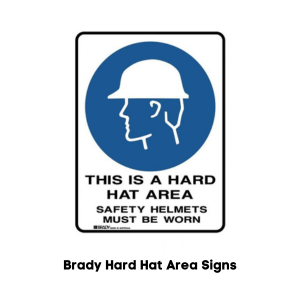 Don’t take your chances* and add to this number. Moreover, hard hats don’t replace common sense and safety precautions, so make sure to always be aware of your surroundings, follow safety procedures and practice hazard avoidance alongside wearing them.
Don’t take your chances* and add to this number. Moreover, hard hats don’t replace common sense and safety precautions, so make sure to always be aware of your surroundings, follow safety procedures and practice hazard avoidance alongside wearing them.
Pro tip: To make sure you and your workers wear hard hats where needed, you may want to install some of these ‘THIS IS A HARD HAT AREA’ safety signs by Brady to keep everyone reminded.
Bottom line: Having safety equipment in place may give a false sense of confidence. Just because you’re wearing a hard hat doesn’t mean you can be less careful.*
*We’re talking about the Peltzman Effect and risk compensation theory which broadly suggest that people adjust their behavior in response to perceived safety (eg when one is wearing a hard hat). The Peltzman Effect specifically argues that safety regulations can inadvertently lead to riskier behavior, offsetting the intended benefits of the regulation. Risk compensation theory is the broader concept where a person has a target level of perceived risk that he/she is comfortable with; therefore, when perceived risk decreases (eg due to safety measures), they may compensate by engaging in riskier behaviors to maintain their desired level of risk.
A more relatable example would be our National Rugby League and how it recently sold to Americans (in Las Vegas last month) with the “no pads, no helmet, no fear” slogan.
Our Managing Director Paul Milchem commented, “This is quite interesting. National Football League (NFL) (gridiron) players wear helmets but our football (Rugby, Rugby League & AFL) do not. It was thought that our players would therefore suffer greater head injuries and concussions. In fact, they found the opposite as NFL players have confidence and just barrel in and butt heads whereas our players work hard to avoid head contact.”
What is the Australian Standard for hard hats?
AS/NZS 1801:1997 Occupational Protective Helmets sets out detailed requirements for the design, construction and performance of helmets designed to protect workers from head injuries caused by falling objects. It applies to helmets used in industries like construction, forestry, mining, and shipbuilding. It specifically requires:
- Helmet construction: The shell must be made of strong, durable materials to withstand impact, and the harness must be adjustable to ensure a secure and comfortable fit.
- Performance test: At the minimum, the helmet must be able to absorb the energy of falling objects and protect against sharp object penetration. Certain types of helmets also offer electrical and flame resistance.
- Markings: The helmet must have clear markings indicating the manufacturer, date of production, type of helmet and standard compliance.
What are the different types of hard hats?
Hard hats combine a tough outer shell to deflect the immediate blow and an inner suspension system to cushion and distribute the impact force, reducing the risk of head injury.
Section 1.3 of AS/NZS 1801:1997 specifies three types of ‘occupational protective helmets’ that applies to hard hats:
- Type 1: Industrial safety helmets with good impact protection for general use
- Type 2: Industrial safety helmets with added heat resistance for high-temperature workplaces
- Type 3: Industrial safety helmets with more extensive protection and specifically designed for bushfire (wildfire) fighting
The AS compliance markings are usually indicated inside the hat:
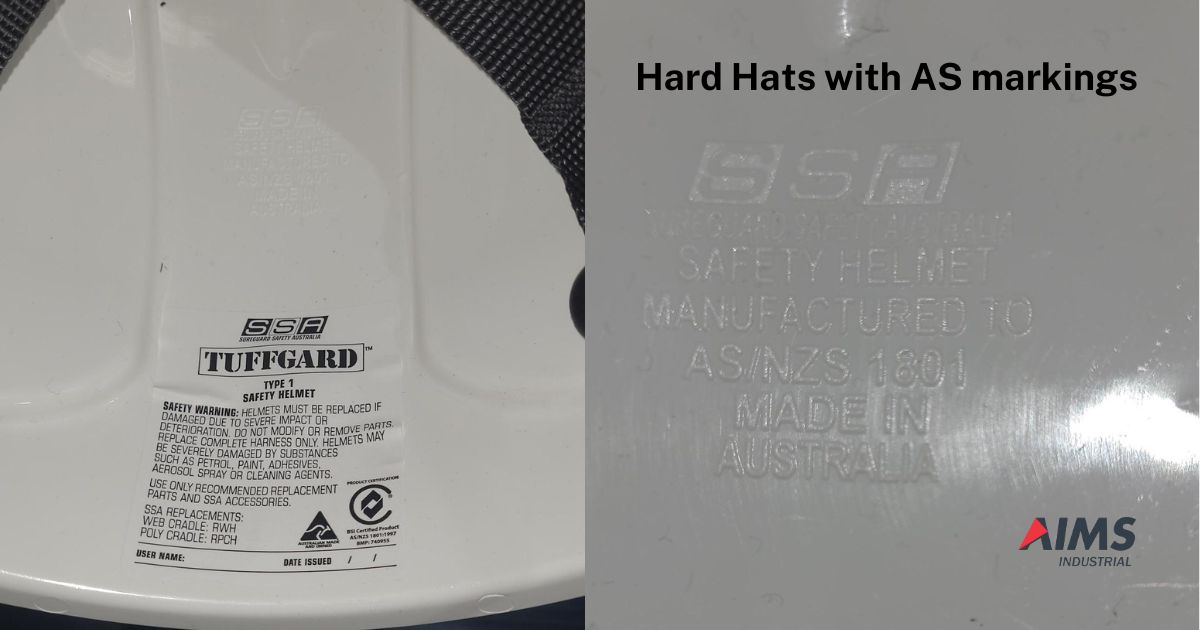
According to SiteSafe NZ: “Some hard hats allow for the attachment of accessories to add further protection such as face shields, respirators, hearing protection and work lamps. When selecting your hard hat, you should also consider whether ventilation or hi-viz colouring is of benefit.”
Are hard hats and safety helmets the same in Australia?
Yes, hard hats and safety helmets are essentially the same thing in Australia. While there might be slight variations in terms of branding or specific features, the core purpose and function remain the same: to protect the head from impact injuries. Both terms are used interchangeably to refer to head protection equipment worn in various industries, such as construction, mining and manufacturing.
How do I properly wear my hard hat?
The harness inside should be adjusted to prevent it from slipping or wobbling. Ensure a snug fit that is neither tilted to nor hanging off loose to any side, and that the harness is properly attached to the shell. The hard hat should sit approximately one inch above your eyebrows.
Here is a video demonstration courtesy of HRP Associates Inc:
More information from SiteSafe NZ:
- Adjust the harness cradle to ensure comfort and total contact with your head at all times.
- It is recommended you do not wear clothing items on your head as this will result in the harness cradle becoming ineffective. This includes hoods, baseball caps, thickly woven or heavily seamed beanies or balaclavas. Some hairstyles such as dreadlocks are also not recommended.
- To secure your hard hat, you can use elastic chin straps, or a four-point retaining strap integrated with a harness when working at height.
- Ensure any attachments are compatible with the make and model of the hard hat.
How do I maintain my hard hat?
Helmets should be inspected regularly for damage and replaced when necessary. Generally, you should follow the manufacturer's instructions for use and care is, which can usually be summarised by the following points:
- Keep it away from direct sunlight, extreme temperatures and chemicals (eg adhesives, paints, paint thinners etc and strong cleaning agents) to prevent damage.
- Do not modify the hat in any way to preserve its integrity.
- Do not interchange, mix, match components (harnesses, shells, straps and suspensions) from different hard hats and manufacturers.
- Do not use it for purposes other than what it’s designed to do (eg do not use it as a makeshift bucket or seat etc).
- Do not drop it.
*If you did, then please refer to the “safety check procedure” at the pro tip below by SiteSafe NZ, but keep in mind that different Australia-specific state rules may apply otherwise. Please refer to our Australian WHS laws article for a list of state-level regulators that can assist you more appropriately for your specific case.
- Use only mild soap and warm water for cleaning and rinsing. Avoid harsh chemicals.
- Replace the sweat bands regularly.
- Replace the suspension systems more frequently, about every year.
- Replace the shell if it appears chalky, damaged or flaked.
Pro tip: Here is a quick safety check procedure according to SiteSafe NZ:
“All hard hat components should be inspected at least weekly for signs of dents, cracks, penetration and damage due to impact, rough treatment or wear. A simple test is to squeeze the sides of the hard hat together and listen and feel for signs of stress or cracking which would indicate brittleness and deterioration. Field tests have shown helmet shells last for three years from issue date. Components of harnesses may deteriorate more rapidly and may need to be replaced.”
Important: Replace the hard hat immediately after it has sustained any impact.
Do hard hats ‘expire’?
Speaking of replacing hard hats, it begs the question of when they should be replaced provided all maintenance and prescribed care are followed.
The short answer: Yes. Generally, and largely depending on usage:
- Actual use: Some industries may require more stringent rules when it comes to replacing hard hats. For example, this NSW Department of Planning & Environment safety bulletin states, “Safety helmets have an effective working life from the date of issue. The NSW Resources Regulator recognises that the effective working life of a safety helmet will depend on several factors. Australian Standard AS/NZS 1800:1998 Occupational protective helmets – Selection, care and use (section 3) states that "field tests indicate that generally, helmet shells have a life of at least three years. Damage to the harness components may deteriorate more rapidly in service and therefore should be replaced at intervals no longer than two years.”
SiteSafe NZ seconds this by saying it is a “good idea to record the date of issue by writing on the inside of the hat with a marker and replacing the hat every two or three years.”
- Frequency of use: Moreover, the same NSW safety bulletin mentions that “helmets used infrequently, stored away from sunlight, dirt and extreme temperatures may not find this guideline / recommendation applicable. Conversely, poorly stored helmets used in extreme conditions of temperature may need replacing more frequently."
What do the different hard hat colours mean?
Here is the hard hat colour-coding for Australia:
- White: For chief wardens, engineers, foremen, managers and supervisors
- Yellow: For general laborers and earthmoving operators (as it promotes better visibility)
- Brown: For workers who usually work in high-heat environments (eg welders) and hazardous areas
- Green: For safety inspectors or probationary workers (as it sometimes signals a need for guidance or extra caution)
- Blue: For technical workers such as carpenters (as it provides visibility without clashing with other common workwear colors)
- Orange: For road crews, slingers and signalers (as its high visibility is crucial if they work near moving vehicles and heavy equipment)
- Red: For emergency personnel (eg fire marshals)
- Grey: For site visitors or anyone with a temporary presence on site
AIMS' Note on Buying PPE and Workwear
- Hazard assessment: Identify the specific hazards you will likely be facing in your work environment. Consider potential risks such as chemical exposure, falling objects, loud noises, electrical hazards or biohazards. This assessment will guide you in selecting the appropriate PPE for the job.
- Appropriate materials: Different materials offer various protective qualities. Consider flame-resistant (FR) materials for fire hazards, chemical-resistant fabrics for handling hazardous liquids and high-visibility options for work in low-light environments.
- Compliance to occupational safety standards: Opt for PPE that meets the pertinent Australia Standard (AS), although some brands -- especially imports -- will have other compliance markings such as ANSI, OSHA, ANSI, NIOSH, oSA etc. Look for certifications on the product label to ensure the equipment has undergone rigorous testing.
- Proper fit and comfort: Proper fit is crucial for both comfort, dexterity and protection. Ill-fitting clothing can snag on machinery or restrict movement, potentially creating additional hazards. Choose sizes that allow for layering in cold weather without being overly bulky and consider adjustable options for items like hard hats or respirators.
- Maintenance and replacement: Inspect PPE before each use for signs of wear, tear or damage. Follow (and factor in) the manufacturer's instructions for cleaning and storage. Some materials may require specialised laundering, while others can be machine-washed. Check for durability to ensure the clothing can withstand frequent use and cleaning. Replace damaged or expired PPE immediately to guarantee your safety.
- Training: Ensure you and any employees understand how to properly use, wear, adjust, maintain and store PPE and workwear. Improper use can negate its protective benefits.

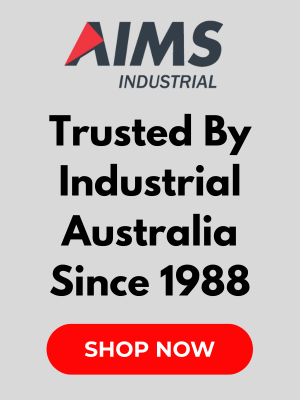
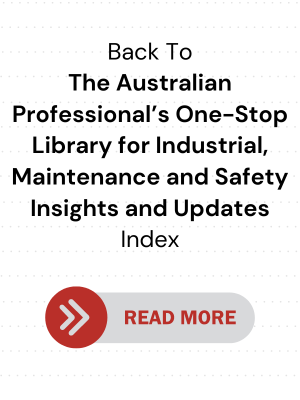
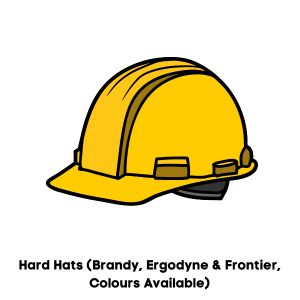
.png)